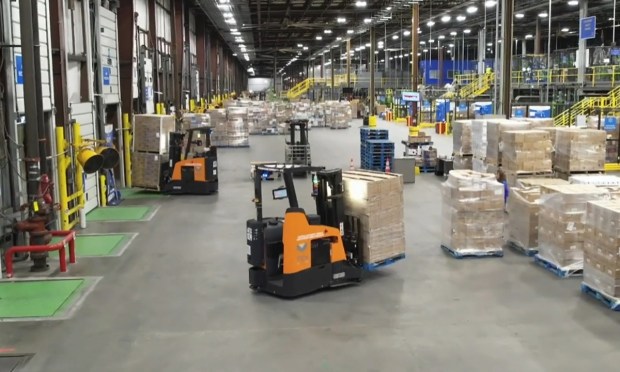
In Walmart’s sprawling distribution centers, a quiet change is underway.
The retail behemoth is preparing to deploy a fleet of 19 autonomous electric forklifts across four of its facilities, marking a significant step forward in integrating AI-powered robots into industrial settings.
As these machines take on the repetitive and strenuous tasks of moving goods, they offer a glimpse into a future where technology and human labor intertwine to create a more efficient and streamlined supply chain. These AI-driven systems are delivering improvements in operational workflows and risk management.
“AI can improve warehousing by orchestrating the automated technology,” a Walmart spokesperson told PYMNTS. ”For us, AI is helping our customers get the items they want — where, when and how they want them. The technology helps coordinate movements, optimize decisions, and, overall, make sure we can get items to our customers fast, easily and efficiently. AI is helping evolve physically demanding jobs into roles where associates are operating and maintaining high-tech systems.”
Walmart has revealed its latest venture into robotic automation, announcing the deployment of 19 fully autonomous FoxBot Class 1 electric forklifts across four distribution centers as part of its ongoing exploration into a robotic workforce.
The leading big box retailer’s rollout is part of a multi-year agreement closely watched by executives, signaling a potential broader adoption of robotic forklifts. This initiative follows a successful 16-month proof of concept at one facility, positioning the company at the forefront of integrating advanced robotics into its operations.
“We’re adding state-of-the-art robotics and automation technology across our supply chain network, including automated storage and retrieval systems,” the Walmart spokesperson said. “These facilities are supported by advanced algorithms that help increase the speed and accuracy in which we’re able to get products to customers and stores, designed to address the complex challenges we face in logistics today. As for our associates, this new approach streamlines the process, allowing them to transition from manual roles to managing high-tech robotics systems.”
Beyond Walmart’s autonomous electric forklifts, companies like Amazon and Ocado are pioneers in deploying AI robots. Amazon has become the world’s largest manufacturer of industrial robots, deploying over 750,000 mobile robots in its operations globally. At the same time, Ocado’s robotic picking systems manage groceries with minimal human contact, Robert Khachatryan, CEO of Freight Right Global Logistics, told PYMNTS.
“DataRobot indicates that smart warehouses utilizing AI and other technologies can enhance supply chain efficiency by 10 to 40 percent,” he said. “While AI and robotics significantly increase efficiency, they are unlikely to replace human workers entirely. Instead, AI is reshaping roles, with humans working alongside robots. For example, AI handles repetitive tasks, while humans focus on supervision, maintenance and decision-making tasks that require complex cognitive skills.”
AI plays a significant role in autonomous mobile robots (AMRs) and pick-and-place robot arms, Erik Nieves, the CEO of Plus One Robotics, told PYMNTS. Two of the most common examples of picking arms in logistics are induction and de-palletization robots. Induction robots use computer vision and AI to process parcels and load sorting machines.
“De-palletization robots rely on AI vision and learning to automatically unload pallets and shipping containers full of disparate items,” he said. “More generally, picking-and-moving robots are being deployed to handle tasks like transferring items from warehouse shelves to outgoing trucks using AI guidance.”
One new use case of AI-powered robotics in the warehouse is through machine learning (ML) and vision capabilities, Andy Williams, executive vice president of North America at warehouse automation company Exotec, noted to PYMNTS. While similar to generative AI models consumers use today, warehouse robotics that uses vision systems also factor in the capability to understand images.
“This has several implications in the warehouse, such as optimizing piece-picking robots so that they can accurately handle loose goods in the warehouse or being able to detect defects in a product before it gets shipped out,” he said. “Other ways ML can be used in the warehouse include path optimization, where ML algorithms help warehouse robots find optimal routes to take to complete their task in the most efficient manner. Or adaptive behavior, which can enable robots to learn from their environment and continue to improve their performance based on their surroundings and external factors.”
Robots could fill in for humans in warehouse jobs that are facing a labor shortage, Nilay Parikh, the CEO of Arvist, an AI Software-as-a-Service company that focuses on supply chain and logistics, told PYMNTS.
“Current warehouse workers are overworked and often under extreme stress to deliver products and goods on time,” he said. “AI-enabled technology solutions can help alleviate many of these pain points, enabling the same worker to maximize their output.”
While robotic and automation technologies may replace some roles, Parikh said the ultimate goal of AI is not to supplant the human workforce but to augment and enhance it.
“Given the lack of workforce availability, these automation solutions minimize human intervention and allow the same workers to focus on higher-value activities such as inventory management and customer service, improving efficiency and customer satisfaction overall,” he added.
A Walmart spokesperson did not provide a direct answer when questioned about the possibility of robots eventually replacing human warehouse workers.
“Our goal is to evolve physically demanding jobs into more fulfilling, higher-skilled roles where associates operate and maintain advanced technology,” the spokesperson said. “We’re transforming physically demanding roles like trailer loaders and case fillers into tech roles like cell and systems operators and maintenance technicians.”